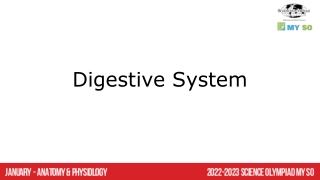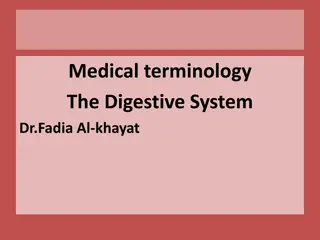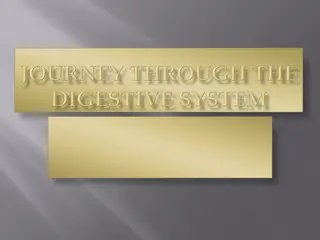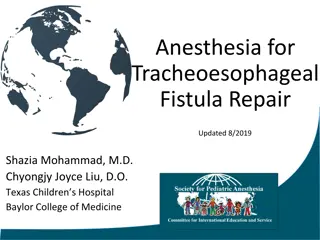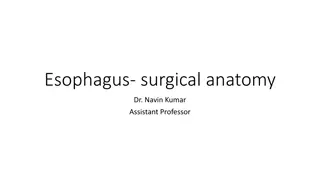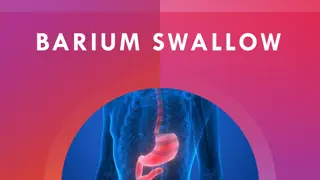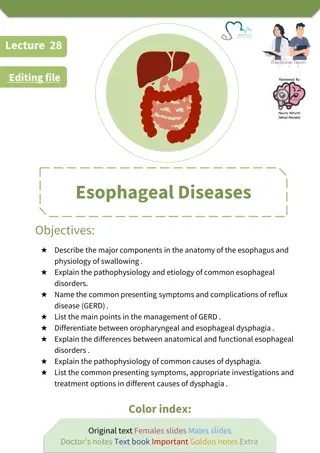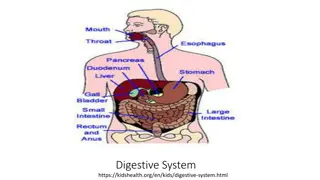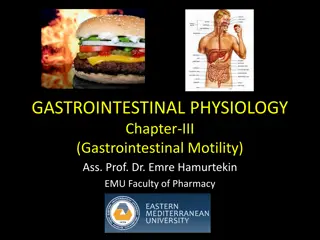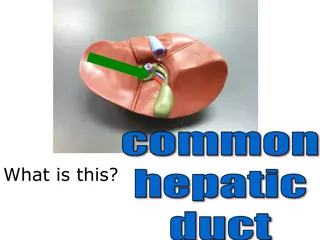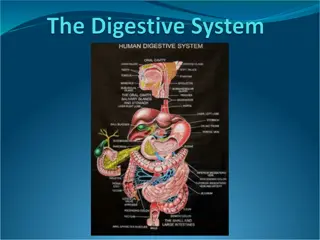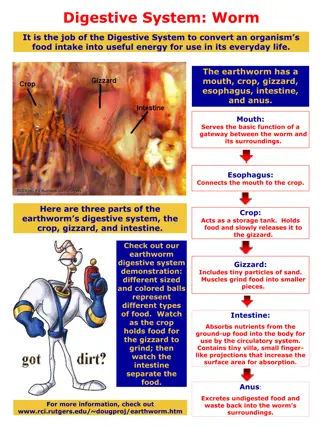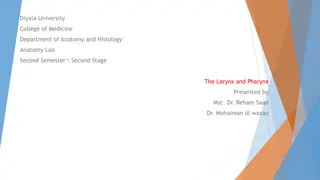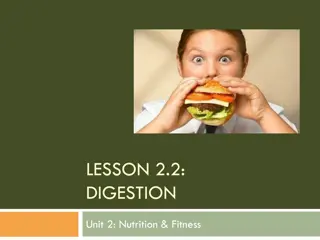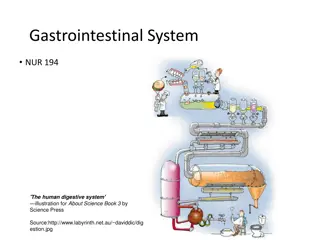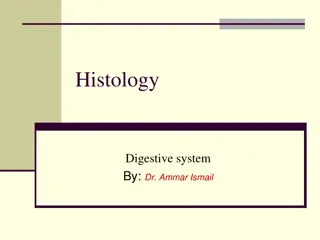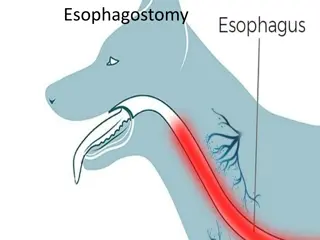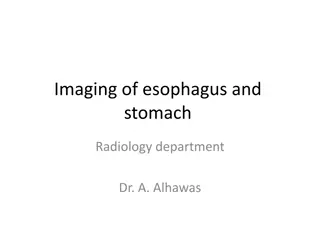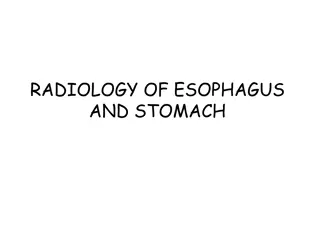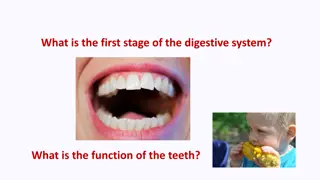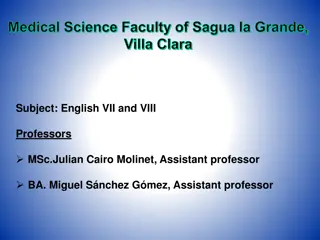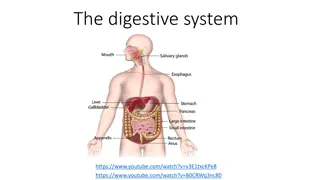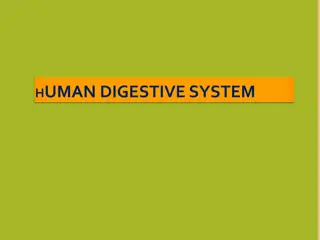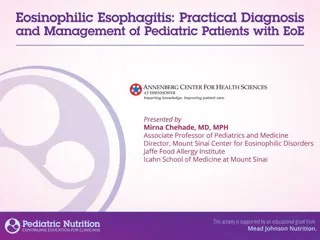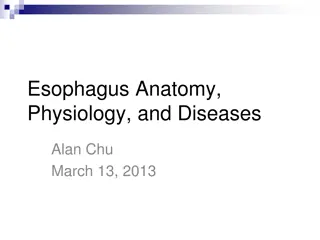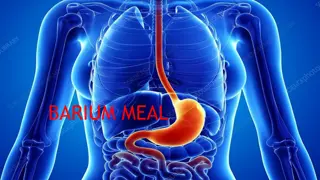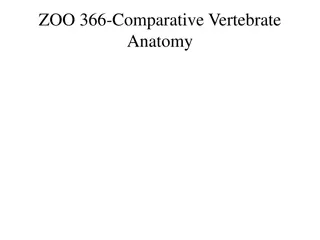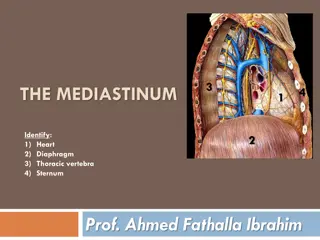Digestive System
Learn about the digestive system's organs and functions in turning food into nutrients for energy and growth. Explore the mouth, throat, esophagus, stomach, and small intestine processes. Discover mechanical and chemical digestion examples.
7 views • 13 slides
Understanding the Digestive System Processes
The digestive system is responsible for the breakdown, absorption, and elimination of food. It involves processes such as ingestion, propulsion, mechanical and chemical digestion, absorption, and defecation. Starting from the mouth with salivary glands and oral cavity, it progresses through the esop
3 views • 38 slides
Physiologie Digestive PHASE BUCCALE
Digestive physiology involves the breakdown of food into simple nutrients for absorption by the body. It includes mechanical and chemical means of food degradation using enzymes from salivary, gastric, pancreatic, and colonic bacteria. The digestive system comprises the mouth, esophagus, stomach, li
4 views • 25 slides
Understanding the Digestive System: Medical Terminology Overview
The digestive system, comprising the gastrointestinal tract (GIT) and accessory organs, plays a vital role in digestion. From the upper GI tract (oral cavity, esophagus, stomach) to the lower GI tract (small and large intestines), each part has specific functions. Understanding salivary glands and c
0 views • 18 slides
The Digestive Journey: From Skittles in the Mouth to Nutrient Absorption in the Intestine
The process begins with chewing skittles in the mouth, where salivary amylase breaks down sugar. The bolus then travels down the esophagus via peristalsis into the stomach, further broken down by gastric juice. The pancreas releases enzymes like amylase and lipase to digest sugars and fats. Bile pro
2 views • 15 slides
Anesthesia Considerations for Tracheoesophageal Fistula Repair
Tracheoesophageal fistula (TEF) is a rare abnormal connection between the esophagus and trachea, often associated with congenital anomalies. This article covers TEF clinical presentation, prevalence, diagnosis, management, and anesthesia considerations. Understanding TEF and its related syndromes is
0 views • 29 slides
Esophagus Surgical Anatomy Overview
This detailed overview of esophagus surgical anatomy covers the anatomical structure and relationships, constrictions, clinical importance, length, blood supply, venous drainage, and nerve supply. The content includes informative images and descriptions provided by Dr. Navin Kumar, Assistant Profess
0 views • 49 slides
Comprehensive Guide to Barium Swallow Procedure
Barium swallow is a dedicated test to evaluate the pharynx, esophagus, and proximal stomach. It helps diagnose conditions like dysphagia, obstructions, and motility disorders. This guide covers the indications, contraindications, preparation, contrast agents used, and evaluation steps for the proced
0 views • 13 slides
Understanding Functional GI Disorders: A Comprehensive Overview
Functional GI disorders encompass a range of conditions affecting the gastrointestinal system, such as irritable bowel syndrome and disorders of the gut-brain interaction. These disorders are characterized by no structural abnormalities but are influenced by factors like motility disturbance, viscer
0 views • 42 slides
Understanding Esophageal Diseases: Anatomy, Physiology, and Disorders
Explore the anatomy and physiology of the esophagus, learn about common esophageal disorders such as GERD, understand the symptoms, complications, and management of reflux disease, differentiate between oropharyngeal and esophageal dysphagia, and delve into the causes, symptoms, investigations, and
2 views • 16 slides
Exploring the Intricacies of the Digestive System
The digestive system plays a crucial role in converting food into nutrients and eliminating waste from the body. It involves a complex network of organs such as the mouth, stomach, intestines, liver, pancreas, and gallbladder. Discover interesting facts and details about the digestive system, includ
0 views • 18 slides
Understanding Gastrointestinal Motility: Key Concepts and Mechanisms
Gastrointestinal motility involves various processes like peristalsis, segmentation, basic electrical activity, and the migrating motor complex. Peristalsis is the reflex response to gut wall stretching, while segmentation helps mix intestinal contents and digestive juices. Basic Electrical Rhythm (
0 views • 19 slides
Identify Various Organs and Regions in Medical Images
The provided content consists of images showing different organs and regions in the human body, such as the liver, pancreas, gallbladder, esophagus, appendix, and more. These images aim to help individuals understand and recognize these structures for educational or medical purposes.
0 views • 53 slides
Understanding the Human Digestive System: A Comprehensive Overview
The digestive system plays a vital role in breaking down food into nutrients for absorption. This process involves stages like ingestion, digestion, absorption, and egestion. Beginning with the mouth, food moves through the esophagus, stomach, and small intestine for digestion and absorption of nutr
0 views • 21 slides
The Digestive System of Worms: Functions and Structure
The digestive system of a worm plays a crucial role in converting its food intake into energy. It consists of various parts such as the mouth, crop, gizzard, esophagus, intestine, and anus. The mouth serves as the entry point for food intake, leading to further digestion through the other components
0 views • 9 slides
Overview of Jejunum and Ilium Histology and Vascular Supply
The jejunum and ileum are segments of the small intestine with distinct features in terms of position, diameter, wall thickness, and lymphoid aggregates. They receive arterial blood supply from branches of the superior mesenteric artery and drain into various venous tributaries. Histologically, the
0 views • 14 slides
Anatomy of the Pharynx: Structure and Function
The pharynx is a musculomembranous tube that connects the nasal and oral cavities to the larynx and esophagus. It is divided into three parts: nasopharynx, oropharynx, and laryngopharynx, each with unique features and functions. Muscles like pharyngeal constrictors and palatopharyngeus play a crucia
0 views • 31 slides
Understanding Digestion: A Journey Through the Digestive System
Dive into the fascinating world of digestion with a focus on the organs involved, processes like chewing and absorption, and the role of nutrients. Explore the journey of a pretzel through the digestive system and learn about key concepts such as the functions of the mouth, pharynx, esophagus, stoma
0 views • 12 slides
Understanding the Human Digestive System
The human digestive system is a complex pathway that starts from the mouth and ends at the anus, involving various organs like the mouth, pharynx, esophagus, and stomach. Each part plays a crucial role in breaking down food particles, absorbing nutrients, and eliminating waste products. From chewing
0 views • 132 slides
Histological Structure of Digestive System in Domestic Animals
The histology of the digestive system in domestic animals, specifically focusing on the teeth and their structures, including short (brachydont) and long (hypsodont) types. Details include the composition of enamel, dentine, cementum, and dental pulp, highlighting the differences in tooth morphology
0 views • 14 slides
Alcohol and Cancer Risk: Understanding the Links
Alcohol consumption is linked to an increased risk of various cancers, including mouth, throat, esophagus, breast, liver, and colorectal cancers. Factors such as ethanol, acetaldehyde, nutrient absorption, estrogen levels, and liver cirrhosis play a role in this risk. Even light drinking can elevate
0 views • 17 slides
Esophagostomy Surgical Procedure Overview
Esophagostomy is a surgical procedure mainly performed to address foreign bodies or esophageal diverticula in animals like horses, cattle, dogs, and cats. The operation involves accessing the esophagus, removing the foreign body, and suturing the esophageal wall. Key steps include making an incision
0 views • 14 slides
Radiology Imaging of Esophagus and Stomach by Dr. A. Alhawas
View detailed radiology imaging of the esophagus and stomach conducted by Dr. A. Alhawas, showcasing various anatomical structures such as the splenic artery, abdominal aorta, common hepatic artery, and more. Explore pathologically changed layers in pyloric stenosis, arterial blood supply to the pyl
0 views • 8 slides
Overview of Esophagus and Stomach Imaging Techniques
This content provides information on various imaging modalities used in examining the esophagus, including CT scan, MRI, Fluoroscopy, US, X-ray, and Nuclear medicine. Detailed images and descriptions of esophageal anatomy, abnormalities, and stomach anatomy are included, along with explanations of p
1 views • 33 slides
Journey Through the Digestive System: From Mouth to Intestines
Explore the stages of the digestive system beginning with the first stage in the mouth where digestion starts with the help of teeth. Learn about the movement of food through the esophagus, breakdown in the stomach, and absorption in the small intestine. Discover the role of peristalsis in moving fo
0 views • 9 slides
Understanding Peptic Ulcer: Symptoms, Diagnosis, and Treatment
Peptic ulcers are holes in the gut lining of the stomach, duodenum, or esophagus. This condition can present with symptoms like upper abdominal pain, bloating, and dark stools. Risk factors include smoking, stress, and certain medications. Diagnosis involves various tests, and treatment includes ant
0 views • 15 slides
Understanding the Digestive System and Its Processes
The digestive system plays a crucial role in breaking down food into nutrients for energy and growth. It involves various organs like the mouth, esophagus, stomach, small intestine, and large intestine, each with specific functions. Food moves through the digestive tract via mechanical and chemical
0 views • 18 slides
Exploring the Human Digestive System: Major Organs and Functions
The human digestive system is a complex network of organs working together to break down food into smaller molecules for absorption. It consists of major organs like the mouth, esophagus, stomach, small intestine, and large intestine, along with accessory organs such as the liver, gallbladder, and p
0 views • 34 slides
Select Reps for Feedback Lunch
This collection features detailed images of various types of epithelium found in different parts of the body, including the bladder, submandibular gland, ileum, uterine tube, esophagus, skin, foot, and trachea. Each image provides a close-up view of the epithelial tissue and surrounding structures,
0 views • 16 slides
Understanding Eosinophilic Gastrointestinal Diseases in Pediatric Patients
This educational material covers the clinical presentation, causes, allergic histopathology, immunopathogenesis, and management options for pediatric patients with eosinophilic esophagitis (EoE). Expert insights are provided on defining EoE, discussing etiology, diagnosing EoE, demographics, and the
0 views • 63 slides
Understanding Esophagus Anatomy, Physiology, and Diseases
Explore the anatomy and function of the esophagus, including its layers, innervation, and common disorders like dysphagia, motility disorders, strictures, and rings/webs. Learn about diagnostic methods such as barium swallow studies and endoscopy, as well as treatment options for conditions like ach
0 views • 18 slides
Understanding Barium Meal Radiological Study
Barium meal is a radiological study of the upper gastrointestinal tract, including the esophagus, stomach, duodenum, and proximal jejunum. It helps diagnose various conditions such as peptic ulcers, cancers, and gastrointestinal obstructions. The procedure involves oral administration of barium cont
0 views • 11 slides
Comparative Vertebrate Anatomy - Alimentary System Overview
The alimentary system in vertebrates undergoes invagination to form a stomodeum and proctodeum, with tissue of mesodermal origin forming the wall of the alimentary canal. Differentiated into regions, the canal includes the buccal cavity, pharynx, esophagus, stomach, and intestine. The system is cruc
0 views • 93 slides
Understanding the Mediastinum: Boundaries, Divisions, and Contents
The mediastinum serves as a vital partition in the thoracic cavity, housing various structures between the pleural sacs. Divided into superior and inferior regions, it encompasses essential organs such as the heart, thymus, major blood vessels, nerves, trachea, esophagus, and lymph nodes. Exploring
0 views • 25 slides
